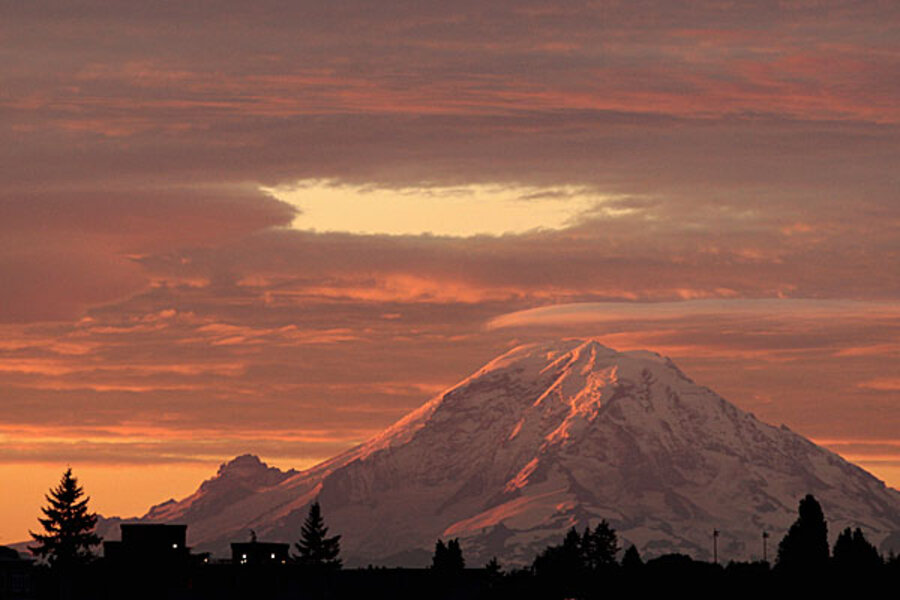Ranger tumbles to his death after rescuing Mt. Rainier hikers
Loading...
| Seattle
Authorities at Mount Rainier National Park faced the grim task Friday of recovering the body of one of their own rangers who slid more than 3,000 feet to his death while helping rescue a climbing party.
Nick Hall died Thursday as he was helping evacuate climbers from a crevasse by helicopter near the summit of the 14,411-foot mountain.
The Chinook helicopter from Joint Base Lewis-McChord removed three of the four climbers from Waco, Texas. Rangers stayed overnight with the fourth person, a woman. The rangers and the remaining hiker started down Friday morning, but park officials still hoped a helicopter would be able to pick her up and also recover Hall's body, said spokesman Kevin Bacher. Six rangers went to recover Hall's body, but that could take several days if the helicopter can't fly.
RECOMMENDED: Eight tales of ordinary heroes
Rain was falling at Longmire, and the National Weather Service said it was snowing above 10,000 feet, the level where Hall landed after the 3,000-foot slide.
"The ideal situation will be the weather would clear up enough for the helicopter to take everyone off the mountain," Bacher said. "Our goal for the day is to have everyone off the mountain by the end of the day."
If a helicopter cannot return to the mountain, the remaining climber, who is with four rangers, should be able to walk out on her own, Bacher said.
Originally from Patten, Maine, Hall was a four-year veteran of the park's climbing program. He was not married and had no children, the park said.
Hall had helped put three of the Texas climbers into a helicopter when he fell about 5 p.m. Thursday. The park withheld the names of the Texas climbers until their families were notified.
They had reached the summit and were on their way down, roped together, when two fell into the crevasse on Emmons Glacier. A third member called for help by cellphone.
"The two women on the end went into the crevasse, but the two men were able to stop the group, and that prevented anyone from falling to the bottom of the crevasse," Bacher said.
Rangers and the helicopter responded to the site at the 13,700-foot level. A helicopter airlifted the three to Madigan Army Medical Center at the military base near Tacoma, but darkness and worsening weather with 40 mph winds prevented the copter from rescuing the fourth climber.
All four were battered and bruised with possible broken bones, but none of the injuries seemed life-threatening, Bacher said.
The park is investigating exactly how Hall fell, Bacher said.
"We don't want what happened to Nick to happen again," he said.
Safety was stressed at the Friday morning briefing for rangers.
"There's no urgency today; nobody's life is at risk today. Let's take it slow and make sure nobody else is hurt," Bacher said.
Hall's family said they were proud of him for his involvement in mountain rescues.
"We sincerely hope the loss of our son will draw appropriate attention to the hazards and safety requirements and commitment to be involved in the profession and sport he so loved," said his father, Carter Hall, from the family home in Patten, Maine.
The family said it was "grieving and celebrating" his life.
Hall was the second Mount Rainier National Park ranger to die this year. Margaret Anderson was fatally shot on New Year's Day as she tried to stop a man who drove through a tire-chain checkpoint at Longmire. Benjamin Colton Barnes, 24, was suspected in a Seattle shooting earlier that day, and his body was found the next day in the snow.
"We're a very small team and particularly the climbing team — basically 15 people under the climbing foreman," said Bacher, who also is a ranger. "And they work very close together and train close together and depend on each other for their lives and become very close."
Rescuers are still looking for four other people — two climbers and two campers — who disappeared on the mountain in a January storm. "We're keeping our eyes out for them as the snow melts out," Bacher said.
About 10,000 climbers attempt to reach the summit of the volcano each year and about half make it, he said.
___
AP reporter Shannon Dininny in Yakima contributed to this story.
RECOMMENDED: Eight tales of ordinary heroes
Copyright 2012 The Associated Press.







